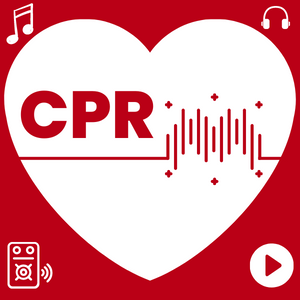THE BEST
CPR PLAYLIST!
Ultimate CPR Playlist
Purple’s CPR playlist is all you’ll need to keep that ideal tempo (100 - 120 bpm) in mind. Our extensive, curated list has 150+ CPR songs for every musical taste, including some current, upbeat favorites. Get moving to the lifesaving beat!
DID YOU KNOW?
-

Most Cardiac Arrests are at Home or in a Public Place
In the US, 80% of cardiac arrests occur outside of a hospital.
Of those, 70% take place at home, 18,8% in public places, and 11.2% in nursing homes.
-

Many Americans Die from Cardiac Arrest
A staggering 475,000 Americans die from cardiac arrest in a year.
-

CPR SAVES LIVES
Currently, 90% of out-of-hospital cardiac arrests (OHCA) result in death. CPR can help.
Early CPR can double or triple a person’s chance of survival.
-

You Can Learn to Save a Life!
We make it easy at Purple. Join a fun, flexible class - at a Purple Center, live online, or we can come to you!
ABOUT CPR
What is CPR, why it’s important, and how to it.
What is the CPR?
CPR stands for Cardiopulmonary Resucitation. It is a life-saving emergency procedure performed when a person’s heart has stopped effectively pumping blood. This sudden loss of heart function is called cardiac arrest.
Cardiac arrest occurs when the heart’s electrical signal that causes the heart to pump blood is either too fast or too disorganized. As a result of this irregular heartbeat, the heart stops effectively pumping blood to the brain and other vital organs. A person in cardiac arrest is not breathing and is unresponsive.
CPR is Very Important. Here’s Why >
When a person is in cardiac arrest, seconds count. Performing CPR temporarily takes over the role of the heart and lungs. Rescue breaths aim to deliver oxygen, and chest compressions aim to keep blood pumping through the body. Through chest compressions and often artificial circulation, the goal is to preserve brain function until advanced emergency medical care can restore spontaneous circulation and breathing.
Death and brain damage can occur quickly during a cardiac arrest event. Four to six minutes after a person stops breathing, brain death occurs. Early CPR can double and even triple the chances of survival for a person in cardiac arrest. This is why, at Purple, we want to see as many people as possible confident to act in case they witness a cardiac arrest. We take this so seriously that we offer Free Hands-Only CPR training.
How to Perform CPR
For CPR-trained individuals: After ensuring scene safety, check for responsiveness and breathing (also pulse for those with advanced BLS training) for 5-10 seconds. If there’s no response or breathing, call 911 and ask someone to get an AED if one is available. Begin CPR immediately, starting with chest compressions at 100-120 beats per minute. Remember the ratio of 30:2 (30 compressions to 2 breaths)! Use an AED as soon as one arrives on the scene.
For other bystanders: Call 911 and push hard and fast in the center of the chest, between 100 and 120 beats per minute. Keep going until EMS personnel arrive, the scene becomes unsafe, or you are too tired to continue.
How Can I Remember the Rate of Compressions?
CPR done well is more likely to result in successful resuscitation. In addition to compression depth and other factors, the rate of chest compressions is a key metric in quality CPR. According to the most recent guidelines, CPR compressions should be performed at a rate of 100 to 120 compressions per minute. A rate that is slower than 100 compressions per minute results in reduced blood flow
You may be one of many who ask, “how would I know what 100 to 120 beats per minute (bpm) feels like?” You’re not alone. This is why CPR training and practice are crucial. It’s important to be prepared when it matters most.
At Purple, we use three tools to help us keep the correct beat: a metronome, 100-120 bpm music, and lots of practice!
Metronome
A metronome is a device that helps keep a steady beat. It produces an audible sound at regular intervals, set in bpm. During training sessions and when we ourselves practice, we use Google's Free Easy Metronome Tool. We set it at 110 bpm, which is right in the middle of the acceptable compression rate range.
Music
Research shows that listening to a song between 100 - 120 beats per minute (bpm) helps people maintain the right rate when performing chest compressions. (*Side note: it, unfortunately, doesn’t help with getting the right compression depth. We’re here to help you practice so you can get both right. 👍)
That’s why the team at Purple curated the best CPR songs playlist available on Spotify. With a wide variety of 150+ songs, you’re sure to find a song you love to help you gain confidence and the CPR compressions rhythm down.
Practice!
And the most important of all three tools mentioned is PRACTICE. Research shows that many do not retain what they learned in CPR training. It’s important to practice to maintain the skills needed to save lives.
Want to know our secret sauce for remembering the correct CPR rhythm?
Using the Ultimate CPR Playlist makes it easy to keep the CPR beat.
Pick your favorite song from our extensive, curated list.
Do these things to the beat: Clap, then tap your hands, then dance, then practice performing chest compressions (not on a real human, please!). *Bonus tip: Be sure to count out loud when doing it. Don’t be shy! All together now — “one and two and three…”
Practice. Practice. Practice. 🔁
Need a refresher on how 100-120 bpm feels? Just revisit our playlist and dance to the lifesaving beat! Like our Spotify Playlist, so it’s easy to listen anytime.






